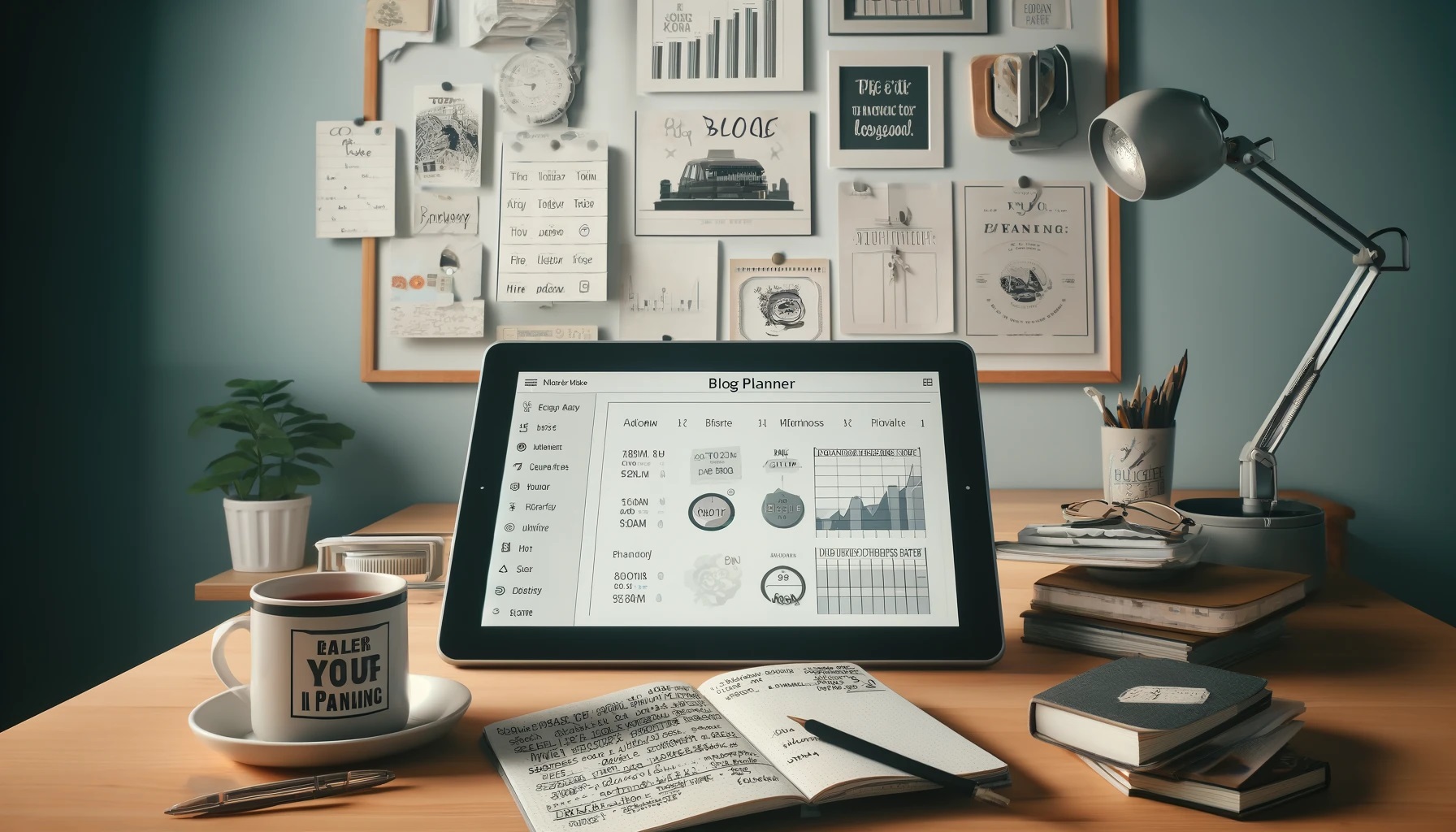Estimated reading time: 19 minutes
Introduction
When you’re ready to take your blogging to the next level, a blog planner can be your best ally. Whether you’re a seasoned writer or just starting out, organizing your thoughts and schedules can transform chaos into a streamlined workflow. A blog planner not only helps you grow your blog but ensures every blog post idea is captured and planned efficiently. With features like monthly calendars, planner pages, and dedicated sections for post ideas, everything you need to publish a blog post or schedule social media posts is at your fingertips.
Imagine never missing a deadline again because your planner includes a comprehensive checklist and worksheet for each post, from inception to publication. Tools like Google Sheets can also integrate seamlessly with the best blog planner, making it easier to track and manage your content. This not only helps in maintaining a consistent publishing schedule but also in participating in affiliate programs and other blog monetization strategies. With all tools and information in one place, using a blog planner is essential for anyone looking to start a blog or enhance their existing one, making it a great blog through effective organization and planning.
Key Takeaways
- Blog planners are essential tools for organizing workflows, ensuring every blog post idea is efficiently captured and planned.
- They help manage time, keep track of due dates, and allow for batching tasks to enhance efficiency.
- Blog planners support creativity by providing structured spaces for idea banks, mind maps, and inspirational quotes.
- They are crucial for tracking progress through metrics like visitor stats, engagement, and SEO rankings.
- Using a blog planner can transform blogging from a disorganized activity into a streamlined and goal-oriented process.
- They are indispensable for anyone looking to start a blog or elevate their blogging, offering both free and premium tools tailored to various needs.
Why Blog Planners Are Essential

Blog planners are essential for anyone who’s looking to start their own blog business. With a free blog planner, you don’t have to go far to find a comprehensive tool that can plan your blog and keep track of your blog’s growth. Whether it’s a content planner, social media planner, or a business planner, using this type of organizer streamlines the process of blog post writing and marketing activities. An ultimate blog planner often includes features specifically designed for printable blogging, making it the elite blog planner to help elevate your content creation efforts.
Streamlining Blog Workflow
Advantages of Streamlining Workflow:
- No More Guesswork: Plan your weekly or monthly posts.
- Time Management: Allocate specific time slots for writing, editing, and posting.
- Due Dates: Never miss a posting date again.
- Batching: Group similar tasks together to be beyond efficient.
How a Blogger Planner Can Help:
- Content Calendar: Know precisely what’s getting posted and when all in organized pages.
- To-Do Lists: Break down big tasks into small, manageable parts on dedicated pages.
- Editorial Notes: Pages to keep track of your ideas and research.
| Workflow Steps | Without Planner | With Planner |
|---|---|---|
| Idea | Scribbled Notes | Organized List |
| Writing | Random Spurts | Scheduled Time |
| Editing | Last Minute | Pre-Planned |
| Publishing | Whenever | On Schedule |
Boosts Creativity: Increase Brain Space, More Ideas
Remember those 2 a.m. blogging ideas? When your mind is cluttered with tasks, there’s less room for creative blogging thoughts. That’s where a post planner swoops in to save the day.
How a Blog Planner Nurtures Creativity:
- Idea Bank: A dedicated post space for all your brilliant thoughts.
- Mind Maps: Visualize how different concepts connect.
- Inspirational Quotes: Keep your spirits high with motivational snippets.
Tracks Progress: Numbers Don’t Lie
We all have goals to see our blog posts grow. Boosting your blog post metrics should be a top priority. Especially when pricing is accessible, even offering zero-cost blog management features. But to do that, you’ve got to know everything from where you’re at to decide where you’re going. Tracking is the GPS of blogging, giving you a place to measure your growth.
Key Metrics to Track:
- Visitor Stats: Are people visiting your blog?
- Engagement: Are they commenting or sharing?
- SEO Rankings: How’s your blog showing up in search engines?
Like a blog calendar or Google Photos, your blogging plan can include monthly or weekly spaces to jot down these key metrics and even schedule posts for promotion. This way, you can easily see if your actions are working.
Here’s a quick reply to a common question: What about black-hat SEO? Steer clear! You want your blog posts to grow naturally. Follow the method, do your steps, and watch your metrics climb. And remember, there’s always the zero-cost blog planner to get you started.
Reaching your goals with your posts isn’t a far-fetched dream when you have a blog post calendar. It’s the tool that transforms your blogging goals into actionable steps.
With separate sections for each task and goal, a blogging timeline helps you categorize your post activities. No more mixing up content ideas with to-do lists or critical metrics. Each section has its pages, making it easier to find what you need when you need it.
Personal Anecdote: My Planner Awakening
Now, it’s time for a little story from my own life. A couple of years ago, my blogging was a hot mess—I was missing deadlines, forgetting ideas, and my posts were all over the place. Then, I finally gave a blog planner a shot. And guess what? It was like seeing in colour for the first time. My workflow became streamlined, my brain had room to cook up additional ideas, and I could track my blog’s growth for the first time.
So, to wrap up this section, whether you’re a seasoned blogger or a newbie reader, a blogging planner is an absolute game-changer for reaching your goals. It organizes your chaotic world of ideas, blog posts, deadlines, and metrics into a neat little package, giving you the headspace and roadmap to succeed. Trust me, it’s a lifesaver.
Comprehensive Guide: Picking the Right Planner
Hey there, savvy blog owners! So, you’ve gotten the hint that a blog organizer can be a lifesaver. But wait a minute—what kind of organizer should you get? From good old-fashioned paper to swanky apps, the options are endless. Let’s dive into the pool of choices, shall we?
Printable Blog Planners: The OG Way
Remember back in school when we used to take notes with pen and paper? Ah, good times! Printable brings back that physical touch.
Pros
- Makes It Real: There’s something about writing down your plans that makes them feel more concrete.
- No Digital Distractions: No further switching tabs or checking notifications.
Cons
- Not Easily Editable: Mess up? You might need to print a new page.
- Space Eater: Need room to store it.
I used a printable blog planner in my early days. I felt extra committed because I had something tangible. But I also remember the hassle of making edits.
| Type | Pros | Cons |
|---|---|---|
| Printable Organizers | Physical, No Distractions | Not Editable, Takes Space |
Blogging Planner Apps: Welcome to the Future
If you’re glued to your smartphone, a management app for blog organization might be your match made in heaven.
Pros
- Edit on-the-Go: Stuck in a line? Use that time to update your blog planner.
- Set Reminders: Never forget a deadline again.
Cons
- Tech Dependent: No phone, no planner.
- Learning Curve: Some apps can be complicated.
Real Talk: I switched to a phone app for convenience in my blogging journey. The reminders were a lifesaver, but it took me a week to get used to it.
| Type | Pros | Cons |
|---|---|---|
| Planner Apps | Editable, Reminders | Tech-Dependent, Learning Curve |
Online Free Planners: Frugal but Functional
Do you love the concept of a planner but are not ready to shell out cash? Online no-cost planners, with printables included, have got you covered. Our basic plan is to get going before deciding on the following action.
Pros
- Cost-Effective: No charges tag attached.
- Universal Access: Login from anywhere to check or update.
Cons
- Limited Features: You get what you pay for.
- Ads Can Be Annoying: Those pop-ups aren’t going close themselves.
Budget-Friendly Tip: I used no-cost online blog planners while testing the waters. It was a good starting point, but the ads drove me up the wall!
| Type | Pros | Cons |
|---|---|---|
| Online Gratis Planners | Charges-free, Universal Access | Limited Features, Ads |
The Ultimate Comparison
So, which blog planner reigns supreme? Honestly, it all boils down to your needs and preferences. Here’s a simple guide to help you decide:
- If you value physical touch, Go for printable planners.
- If you’re tech-savvy, Planner apps are for you.
- If you’re budget-conscious, Try an online no-cost planner.
So there you have it, a comprehensive guide to picking the blog post planner that helps you meet your goals. No more excuses for scattered ideas or missed deadlines, folks!
A blog post planner isn’t just about keeping track of posts; it’s about aligning your daily tasks with your goals. That’s how you go from scribbling ideas to running a successful blog.
Template Designs to Elevate Your Blog

Template designs are crucial if you’re looking to start maintaining a consistent blogging schedule. A good blog planner should include printable PDF pages that let you track your blog and keep track of your blog activity through the year. Whether you’re drafting a great blog post or planning blog maintenance, this planner provides all the steps you need to take. Creating content becomes smoother when you can visualize the new content schedule and note down content you need. For those who want something a bit more tailored, most planners allow for customizations—add as many as you need to make it fit everything I need.
Fancy Designs: Pretty but Practical?
Who doesn’t like a beautifully designed planner, right? You can choose based on your core ideas, from fancy designs to simple Microsoft templates. These fancy templates usually have creative layouts, colors, and fonts.
Pros
- Aesthetically Pleasing: Makes planning feel less like a chore.
- Built-in Features: Think goal trackers, inspirational quotes, or habit trackers.
Cons
- Can Be Overwhelming: Too many features could make it confusing.
- Cost: These usually aren’t without charge.
Personal Take: I once splurged on a designer product. It was pretty and all, but half the features went unused. It’s gorgeous but a bit overkill for my needs.
| Type | Pros | Cons |
|---|---|---|
| Fancy Designs | Aesthetic, Feature-Rich | Overwhelming, Costly |
Simple Microsoft Templates: Oldie but Goodie
Ah, Microsoft Office—the OG of digital productivity. If you value functionality over Flash, MS templates can be a game-changer.
Pros
- Familiar Interface: You’re ready if you’ve used MS Word or Excel.
- Customizable: You can easily tweak these to fit your specific needs.
Cons
- Not Flashy: They get the job done but might lack the ‘wow’ factor.
- Limited Built-in Features: You may need to add extras like trackers manually.
Real-World Example: I’ve used Microsoft Excel to generate a simple blog content calendar. It wasn’t as glamorous as a designer planner, but it did the job.
| Type | Pros | Cons |
|---|---|---|
| Microsoft Templates | Familiar, Customizable | Basic, Limited Features |
When picking a blog planner, remember January is the start of a new year and a perfect time to schedule your posts. Use this month to plan topic themes, reply to users’ comments, and engage in bloggers’ promotions. Setting the tone in January will help you have a more organized blog for the year.
What’s the Verdict?
The design you choose has to align with your goals. Here’s how you can pick your ideal template:
- If you need motivation, A fancy, inspirational design may help you stay engaged.
- If you love simplicity, Microsoft Templates are straightforward and effective.
So there it is—whether you’re into glam designs or basic functionality, there’s a suitable template. Just remember, the best planner is the one you will use. Happy planning!
SEO-Friendliness: Attract Readers and Master Your Blog Calendar

Hey there, savvy readers! SEO can’t be an afterthought if you’re serious about getting your blog post to the top of the search engines. And guess what? Your blogging roadmap can be your best friend in making your blog SEO-friendly. Let’s not forget about those special events.
Keyword Research: The Start of Your SEO Journey
Before you jot down anything in your planner place, you’ve got to do some keyword research.
Steps to Solid Keyword Research
- Use Tools: Google Keyword Planner, SEMrush, Ubersuggest—you name it.
- Analyze: Check search volumes, competition, and keyword difficulty.
- Choose: Pick the right keywords that align with your content.
I remember writing a post on ‘homemade cookies’ only to discover that ‘DIY cookies’ had a higher search volume. Don’t be me; do your research.
| Keyword Research Steps | Tools to Use | Why It’s Important |
|---|---|---|
| Search & Analyze | Google Keyword Planner | Targets audience queries |
Content Buckets: Make Your Life Easier
Now that you’ve got those keywords, how about organizing them? That’s where ‘Content Buckets’ come in.
Creating Buckets
- Group Similar Keywords: Make categories like ‘Cookie Recipes,’ ‘Baking Tips,’ etc.
- Assign Priority: Some buckets will be extra critical based on search volume or relevance to your audience.
When I started using content buckets, I no longer had to scramble at the last minute for blog ideas. Everything became clear as day.
| Bucket Strategy | Example | Benefit |
|---|---|---|
| Group and Prioritize | ‘Cookie Recipes’ Bucket | Easier content planning |
Content Calendar: The Real MVP
Let’s slot these buckets into a content calendar within your blog organizer. This is your roadmap to blog success.
Steps to a Killer Content Calendar
- Consistency: Aim to post consistently. If ‘Cookie Recipes’ is a weekly thing, stick to it.
- Seasonality: Plan for holidays and events. They’re SEO goldmines.
| Calendar Tips | Example | Why It’s Cool |
|---|---|---|
| Consistency & Seasonality | Why It’s Cool | Drives regular traffic |
Event Planning Tools for Your Blog: Managing Pages
Now, for those exceptional occasions like product launches or blog anniversaries. It would be best if you were planning for these.
Tools to Use
- Google Calendar: Good for general planning and reminders.
- Event Planning Software: More specialized options for extra significant events.
Quick Tip: For my blog’s 5th anniversary, I marked it in my planner six months in advance and planned an epic giveaway. It was a hit because I was prepared.
| Event Tools | What They Do | Example Use |
|---|---|---|
| Google Calendar | General Planning | Blog Anniversary |
Your All-in-One Strategy
So here’s the playbook to achieve your blogging goals:
- Keyword Research: To hit those SEO goals.
- Content Buckets: To keep you sane and organized.
- Content Calendar: For that rock-solid game plan.
- Event Tools: To make those exceptional days even beyond extraordinary.
There you have it, folks. Your blog planner isn’t just a notebook or an app; it’s your strategic command center. From SEO to exclusive events, you can take on the blogging world like a pro.
Shopping Guide for Your Next Blog Escapade

So, you’re looking to take your blogging to the next level and decided that a content scheduler is your secret weapon. Awesome choice! Let me break down what you should keep an eye out for. Trust me, I once thought any notebook would do. But having the right planner was like going from a tricycle to a race car. Let’s zoom into it!
Budget
We all know money talks, but that doesn’t mean you should splurge on a planner if you don’t need to. So, first things first—set a budget.
- Low-end ($5-$15): Basic paper planners. You jot down what you want. No frills.
- Mid-range ($16-$40): Features like goal setting, analytics tracking, or habit monitoring.
- High-end ($41 and up): These are like the Lamborghini of organizers. Digital syncing, full customization—you name it.
I once splurged on a high-end planner. It was beautiful, but half the features went unused. It’s like having a Ferrari but only driving in your backyard. Don’t be me. Look out for a free version of software that may be useful. Know what you need and stick to it.
Features
Going for a planner loaded with features is tempting, but knowing what you need is crucial.
- Weekly Layouts: Good for broad planning and general overview.
- Daily Timelines: Perfect if you’re into details.
- Goal Sections: Great for target-driven people.
- Note Sections: Useful if you jot down ideas spontaneously.
- Analytics Trackers: For those who love numbers.
Chart for Quick Reference
| Feature | For Whom | Good For |
|---|---|---|
| Weekly Layouts | General Planners | Overview |
| Daily Timelines | Detail-Oriented People | Micro-planning |
| Goal Sections | Target-Driven | Objectives |
| Note Sections | Creative Minds | Brainstorming |
| Analytics | Number Crunchers | Monitoring |
I thought I needed all the bells and whistles. I bought a planner with daily, weekly, and monthly sections, habit trackers, and more. Guess what? I only used the weekly cells and the note spaces. Features are excellent, but only if you use them.
Accessibility
Let’s talk about how easy it is actually to use this thing.
- Size: Do you need something that fits your backpack or takes up your entire desk?
- Digital vs. Physical: Are you a pen-and-paper person, or do you thrive in the digital world?
- App Integration: Some organizers sync with apps for an extra layer of organization.
I tried a digital planner but found myself missing the act of writing. There’s something about pen on paper that makes stuff real for me. Your Experience might differ, so consider what feels most natural.
In summary, your perfect planner doesn’t necessarily have all the premium features or the highest rate tag. It’s the one that fits your life. Consider these considerations, and you’ll find the planner that’s just right for you. No more questions. You’re all set!
Creating Downloadable PDF
Hey there, savvy blogger! So, you’re considering stepping up your game by offering downloadable PDF blog organizers on your site. This boosts your blog’s professionalism and provides real value to your audience. Let me explain how to get this done and why it’s a game-changer for your content marketing.
Why PDFs?
Before we dive into the ‘how,’ let’s talk about the ‘why.’ PDFs are super usage-friendly. They’re easy to download, share and look the same on almost every device.
- Usage-Friendly: Easy for bloggers to download and use instantly.
- Professional Touch: Makes your blog seem more like a resource hub.
- Consistency: Looks the same whether you open it on a phone or a 20-inch monitor.
Quick Fact: Did you know PDFs can improve your blog’s SEO? Search engines can crawl and index the text inside them, giving you extra points for relevance and value!
Tools You’ll Need
First off, you’ll need some tools to generate your PDFs. Here are some popular options:
- Adobe Acrobat: This is the heavyweight champ of PDF creation, but it can be a bit pricey.
- Microsoft Word: Believe it or not, you can create PDFs from Word.
- Google Docs: Free and super easy to use.
- Canva: Great for adding snazzy designs and visuals.
Tool Comparison Chart
| Tool | Price | Features | Ease of Use |
|---|---|---|---|
| Adobe Acrobat | $$$ | Extensive | Moderate |
| Microsoft Word | $$ | Moderate | Easy |
| Google Docs | Free | Basic | Easy |
| Canva | Free/$ | Moderate (Design-Centric) | Very Easy |
I started using Google Docs because it’s free and straightforward. But as my needs grew, I moved on to Adobe Acrobat. The smooth transition offered many features I didn’t even know I needed.
Steps to Create Your PDF Blogging Planner
Alright, let’s roll up our sleeves. Time to create!
- Outline Your Content: Decide what elements you’ll include, like monthly timetables, to-do lists, or goal-setting sheets.
- Design the Layout: Make it visually appealing. Trust me, design matters.
- Add Interactivity: Include clickable links or editable fields for a richer consumer experience.
- Test: Always preview your PDF on different devices to ensure it looks good everywhere.
- Export and Optimize: Save your file in a web-friendly format and optimize it for faster downloads.
Personal Experience: My first PDF was a disaster. I didn’t test it on mobile, and all the text overlapped. Don’t skip the testing phase. Ever.
Sharing Your PDF
Now that you’ve created this excellent PDF planner, it’s time to share it with the world.
- Direct Download: This is the simplest way, but not great for tracking who’s downloading.
- Email Subscription: Excellent for growing your mailing list.
- Social Media: Use as a freebie to attract more followers or even as a paid resource.
Creating a downloadable PDF blog planner means doing more than just sharing a helpful bloggers’ tool. You’re building your brand, establishing authority, and, most importantly, giving your audience something of real value. Trust me, they’ll notice. And that’s all you need to know to get started! No more lingering questions, promise.
Practical Tips for Maximizing Your Blog Plan
Okay, so you’ve got your shiny new blog management tool. High five! But let’s be honest: owning and using a planner blog effectively are two different things. Here’s how to get the most juice out of this tool so that it becomes your blog’s best friend.
Daily Check-ins: Spend 5 Minutes Each Morning
You know how people say, “Start your day right”? Well, this applies to your blog agenda, too. Spend just 5 minutes every morning with it.
- Review Goals: Look at your big and small goals for the week.
- Prioritize Tasks: Decide what needs immediate attention.
- Time Blocking: Allocate specific times for each task.
Personal Experience: I used to dive straight into my emails every morning—wrong move. I felt scattered all day. Now, my planner sets the pace, and I’m in control.
Set Reminders: Don’t Rely on Memory
Our brains are impressive, but they’re not foolproof. You’ve got your phone for calls and your computer for work—let your planner be the boss of your blog.
- Sticky Notes: Old school but effective for quick reminders.
- Digital Prompts: Use planner apps that offer reminder features.
- Visual Cues: Use colors or symbols to make important stuff stand out.
Quick Tip: Set digital reminders a day before a big deadline. That gives you a safety net if you’ve forgotten something.
Track Metrics: Numbers Don’t Lie
Metrics are the heartbeat of your blog. These numbers tell you what’s working and what’s not.
- Traffic Stats: More visitors usually mean you’re doing something right.
- Engagement: Comments and shares indicate a higher level of consumer involvement.
- Conversion Rates: Are people taking the actions you want them to take (like subscribing or buying a product)?
Key Metrics to Track
| Metric | Why It’s Important | How Often to Check |
|---|---|---|
| Traffic Stats | Indicates popularity | Weekly |
| Engagement | Measures involvement | After Each Post |
| Conversion Rates | Shows effectiveness | Monthly |
Personal Anecdote: Tracking metrics transformed my blog. I saw a 20% traffic increase within just one month of noting what worked and what didn’t in my planner. It was like finding a map where I was wandering in the dark before.
Make Your Planner Work for You
Here’s the deal: your blog planner is more than just a bunch of pages or an app. It’s like a personal assistant that never takes a day off. Use it to manage your time, remind you of critical tasks, and, most importantly, track your success. Trust me, the more you use it, the more indispensable it becomes.
So, start each day with a quick check-in, pepper your planner with reminders, and get cozy with those metrics. This way, you’re not just scribbling in a notebook but strategically planning your blog’s success. And hey, that’s why you got a planner in the first place, right? You’re all set; no questions left!
- Wireless Over Ear Bluetooth Headphones
- 60H Playtime, Hi-Res Audio, Deep Bass, Memory Foam Ear Cups
- Travel, Home Office
Conclusion
As we conclude, it’s evident that a blog planner is an indispensable tool for anyone serious about managing their blog and business. Using this planner for bloggers, which includes an editorial calendar and a marketing planner, facilitates a seamless blogging workflow, helping you keep track of all the tasks you need to effectively publish your blog. Whether it’s planning your content strategy or scheduling blog promotion, the right planner will help ensure you never miss a beat.
Incorporating a daily planner or a life planner into your routine not only assists in organizing your personal and professional tasks but also enhances your ability to track your blog’s progress. Each year, updating your blog planner with the latest blog template and blog checklist can breathe new life into your blogging strategy, making it a critical component of your success. Ultimately, this planner acts as your roadmap, guiding you through the complexities of digital content management.

James Dunnington leads the James Dunnington Collection, featuring five unique blogs: a practical Pet Care Guide, an enlightening Ancient History Blog, a resourceful Home Improvement Guide, a cutting-edge Tech Innovation Guide, and a strategic Online Money Making platform. Each site delivers valuable insights designed to empower and inform. For updates and more tips, visit our Contact Us page to sign up for our newsletter, ensuring you never miss out on the latest content from any of these dynamic fields.

